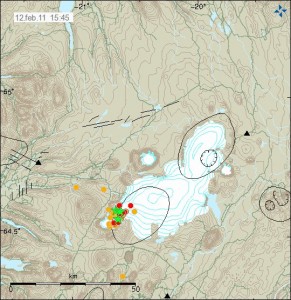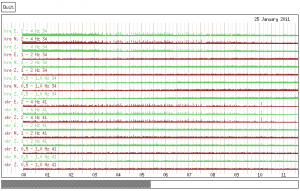Euro foreign exchange reference rates (ecb.int)
While I am thankful for the all the readers that I get on this site it does not change the fact that I need to earn a good living. Currently I am on a fixed income (Welfare) due to my Asperger’s syndrome, but I have a really mild version of this syndrome. This fixed income is not a lot and never has been. But due to my move to Denmark is going to get even less. In Iceland I got 159000 ISK (about 997€, the exchange rate euro/ISK is poor at the moment) but when I moved to Denmark it is going to get lower and in the line of something about 138000 ISK (about 865€). So I don’t have a lot of money to work with over the month.
While this blog originally started as a minor blog about earthquakes and volcanoes in Iceland it grew fast. From September 2010 and until today this blog has had 424,518 page views. My helicorder web pages have had 2,090,461 page views since I did set those pages up (the year 2006). Based on this fact I did decide to try being a professional blogger. That includes getting enough money to live from this blog. I do not know how long that is going to take. But given how long it took University today (started as a blog) to get into that status I might have to wait few more years until I get enough income from this blog to get a stable living from writing on the blog site about Icelandic volcanoes and earthquakes.
This leads me to the ever ending results that come from this type of situation. I need to get a job. That evidently is going to give me less time to attend to this blog. I also plan going to school here in Denmark to learn programming, languages and electronics (if I can learn electronics). So work with that is going to give me less time in the end to write here. But the school is few months off so I am just going to wait and see how that goes. As I sad in a comment yesterday there might be a delay until updates return to normal because I lack the tables to setup my computers properly. There also might be a delay until everything gets back to normal updates, as it might take a good time to get connected a ADSL2+ service. I do not know when I get ADSL2+ connection, as I do not know the service time here in Denmark. Currently I am on poor 3G connection for the internet.
I am a writer and my plan is to write and publish eBooks to sell on Amazon. I am also thinking about releasing them in a blog format (I am still considering that option). I hope to get a income from that in the future. But there is going to be a while until I can start selling eBooks on Amazon and get a income from that sale.
Due to how low income I have. I have decided to do a little fundraiser here. For two tables that I need and a new (or used) PC monitor. I am going to do this as cheap as possible.
Computer Table price is 400 DKK (they did rise the price, damit!) – This is just a normal table. I do not like computer special boards.
TV table price is 300 DKK.
23″ LCD PC monitor price is 999 DKK last time I did check. There might be cheaper 23″ LCD PC monitors for sale in Germany. But I do not know the price on them. I might also buy a used PC monitor to use for a short time while I try to get the money for a new PC monitor. This are the prices where I live locally. But I want to buy this locally so I can get this items right away.
All other support besides this is also welcomed. I must point out that I can only transfer funds that go into my PayPal account into my credit card at the moment (I do not know if that changes when I setup a new PayPal account for Denmark). So any usage that I have there is going to minus first from whatever I transfer into that card. PayPal also takes 5% of whatever I transfer into my credit Card.
Here is the PayPal donate button. This the first time that I do this type of button. So please let me know if there are any issues with it.
Euro foreign exchange reference rates (ecb.int)
Thanks for the support! This blog is going to remain free as always. That is not going to change.



